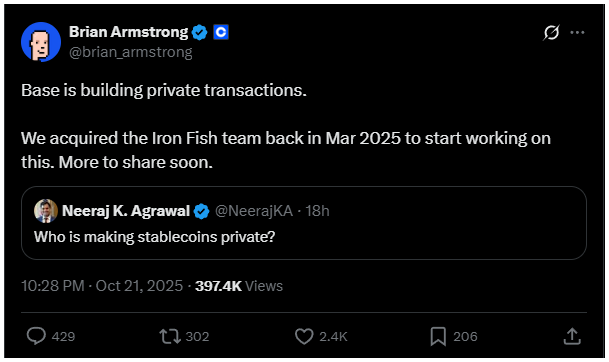Coinbase CEO Brian Armstrong said, “Base is building private transactions,” linking the plan to Coinbase’s March acquisition of Iron Fish.
He posted the update on X. He did not answer questions about KYC or timelines. He said more details will arrive soon.
Stay ahead in the crypto world – follow us on X for the latest updates, insights, and trends!🚀
This places private transactions on the Base roadmap. It frames privacy inside an Ethereum layer-2 used by many developers.

The message highlighted Iron Fish as the core privacy team. It also tied privacy to stablecoin payments.
The announcement followed months of work. Iron Fish shipped tools that use zero-knowledge proofs and view keys. The approach aims to keep transfers private while enabling audits.
Private Transactions on Base: Coinbase and Iron Fish set the stage
Base sits on Ethereum and processes lower-cost activity. Therefore, private transactions on Base would reach a wide audience. Brian Armstrong said the work targets stablecoin transfers first.
He wrote, “Base is building private transactions,” without launch dates. He did not describe the data flow or custody model. He also did not confirm KYC rules for private flows.
However, the Iron Fish link signals a direction. Iron Fish joined Coinbase in March. The team already supports privacy on 20+ blockchains. That list includes Base via a bridge path.
Iron Fish Privacy Model: zero-knowledge proofs and view keys explained
Iron Fish uses zero-knowledge proofs to verify payments without exposing full details. The proofs confirm validity while hiding amounts or addresses. This lets users keep sensitive data off public screens.
At the same time, Iron Fish issues view keys. A view key provides read-only access to transaction history. Users can disclose it to auditors or tax authorities when required.
This design differs from mixers with no audit hooks. View keys create an optional path for checks.
Meanwhile, zero-knowledge math keeps routine transfers private. Together, the tools deliver private transactions with controlled transparency.
USDC on 20+ chains: Base already has a privacy route
Iron Fish says it supports USDC privacy across 20+ chains. It lists Base among those networks. The path runs through ChainPort, a cross-chain bridge.
We’re incredibly proud of all that we’ve built:
👉 L1 PoW with custom algo (Fish Hash)
👉 Encrypted transactions via ZKPs
👉 First privacy L1 to ship Multi-Asset Shielded Pool (MASP)
👉 First L1 to have private multisig wallets via FROST DKG
👉 First to have Ledger…— Iron Fish (@ironfishcrypto) March 6, 2025
ChainPort adds real-time threat checks on funds. It screens flows before assets enter the network. The goal is to keep “only clean funds” in circulation.
As a result, USDC can move with privacy today using the Iron Fish stack. Yet Coinbase now points to a Base-native feature. The difference matters for user experience and policy.
Compliance Questions: KYC, disclosures, and enforcement access
Brian Armstrong did not say if KYC will be required. He did not outline how view keys would be requested. He did not state who can trigger disclosures.
Still, the view key model suggests optional visibility on records. A user can share a view key to grant read-only access. That aligns with audits, taxes, and routine checks.
The enforcement climate remains strict. Cases around Tornado Cash and other tools show that. Therefore, private transactions on Base will draw scrutiny. Coinbase, Base, and Iron Fish must document controls clearly.
What changes for users on Base: private transactions, stablecoin focus, simple flow
For users, private transactions would hide details from public explorers. Transfers would still verify on Ethereum layer-2 rails. Zero-knowledge proofs would confirm correctness.
For teams, view keys would support audits. They would allow selective visibility when needed. They would not permit spending or changes.
For stablecoin flows, USDC appears first in scope. Base supports heavy USDC activity already. Coinbase and Iron Fish aim to add privacy without breaking compliance.
Next details to watch: timing, KYC policy, and on-Base architecture
The next posts should cover timelines. They should explain whether KYC is mandatory. They should outline how view keys integrate with Base wallets.
They should also clarify how ChainPort fits, if at all. A direct Base path could remove extra steps. That would keep private transactions simple to use at scale.
Until then, the facts stand. Brian Armstrong said “Base is building private transactions.” Coinbase owns Iron Fish since March.
Iron Fish uses zero-knowledge proofs and view keys. USDC privacy already runs on 20+ chains, including Base, via ChainPort.
Disclosure:This article does not contain investment advice or recommendations. Every investment and trading move involves risk, and readers should conduct their own research when making a decision.
Kriptoworld.com accepts no liability for any errors in the articles or for any financial loss resulting from incorrect information.

Tatevik Avetisyan is an editor at Kriptoworld who covers emerging crypto trends, blockchain innovation, and altcoin developments. She is passionate about breaking down complex stories for a global audience and making digital finance more accessible.
📅 Published: October 22, 2025 • 🕓 Last updated: October 22, 2025


